What do candidates on the Electrical Duty Holder (Authorised Person) course actually do?
The Duty Holder course is often 'tuned' to suit the audience and our instructors like to get feedback from the candidates as the course progresses but the following gives a general breakdown of the main parts of the course. The course begins by learning about the Electricity at Work Regulations.
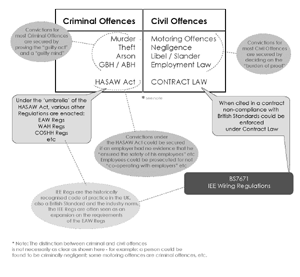
The Legal Implications: We begin by analysing the legal situation regarding the Electricity at Work Regulations. Candidates learn about the relationships between the relevant legal Acts, codes of practice and regulations (the Health & Safety at Work Act, the IEE Wiring Regulations etc).
Candidates are engaged in this part of the course by exploring the various scenarios that might arise - for example: Would non-compliance with the EAW Regs be a criminal or a civil offence? In what situations would compliance with the EAW regulations be necessary? Would a defence be needed to prove compliance with the EAW Regulations?
This analysis of the legal situation helps the candidates to clearly see the scope of the regulations - who, where and what they apply to. A syndicate exercise is staged here to help to reinforce these issues.
We then look at the broad subject area of the regulations so that the candidates can start to understand what the regulations cover and (in general) what the Regulations are trying to achieve. The definitions are then clearly explained - this is important as the meaning of 'live' or 'charged', for example, can have far-reaching implications when considered in the context of the specific requirements of the individual EAW regulations when they are studied later on in the course.
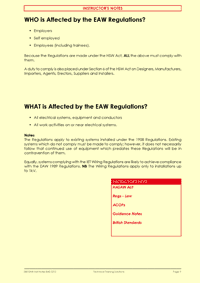 |
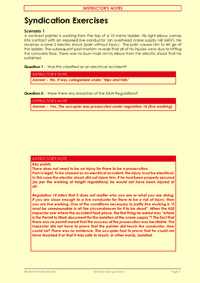 |
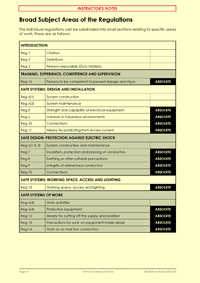 |
Page 10 of the course notes for the Duty Holder (Authorised Person) course, describing who and what is affected by the Regulations |
Page 11 of the course notes for the Duty Holder (Authorised Person) course, where we introduce syndicate exercises to engage the candidates in thinking about what the Regulations would have to say about various scenarios |
Page 12 of the course notes for the Duty Holder (Authorised Person) course, listing the broad subject areas of the Regulations and highlighting which regulations are absolute requirements |
A structured slide-show is used by our instructors to help convey the meaning of each of the EAW Regulations. Candidates can read the exact wording of the Regulations provided in the course notes and then discuss what this means in reality.
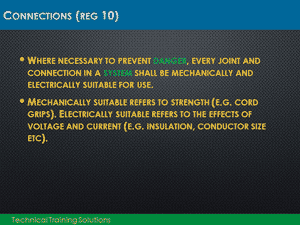 |
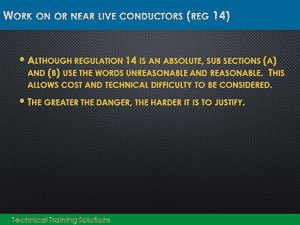 |
One of the Slides used for the Duty Holder (Authorised Person) course, explaining the requirements made by the EAW Regulations with regard to electrical connections |
One of the Slides used for the Duty Holder (Authorised Person) course, explaining what the EAW Regulations mean by working live |
We then look at the issues surrounding the term 'duty holder' referred to in the EAW Regulations. This is an important concept as the candidates need to be made aware who might be held legally responsible. It is also important that candidates gain a proper understanding of the effects of electric shock, and this subject is taught next, with research information and graphs shown of the known effects of electric shock in the candidates' course notes.
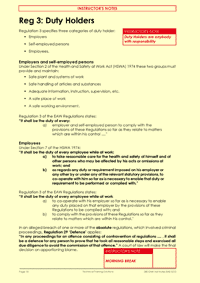 |
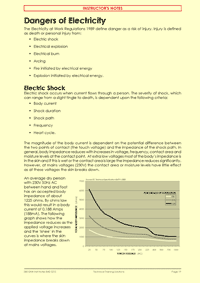 |
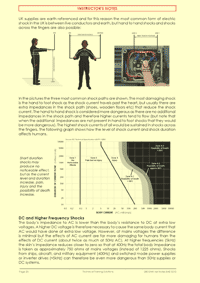 |
Page 13 of the course notes for the Duty Holder (Authorised Person) course, describing the term 'duty holder' used in the Regulations |
Page 14 of the course notes for the Duty Holder (Authorised Person) course, explaining the effects of electric shock |
Page 15 of the course notes for the Duty Holder (Authorised Person) course, explaining the effects of electric shock |
We also show the candidates a short video which helps to explain the regulations in a slightly different context. The following are screen shots from this video, depicting the issues of live working.
 |
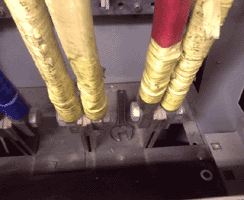 |
Part of the video used for the Duty Holder (Authorised Person) course, depicting some of the issues surrounding live working |
Part of the video used for the Duty Holder (Authorised Person) course, depicting some of the issues surrounding live working |
We then look at the important issues surrounding the term 'competence' referred to in the EAW Regulations. We look at how this relates to the candidates' work activities and the issues of supervision etc. The next regulations we study are regarding the issues of insulation, earthing and isolation. The following are extracts from the candidates' course notes.
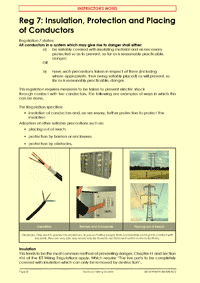 |
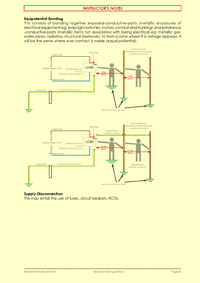 |
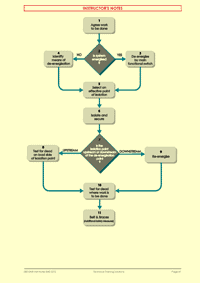 |
Page 24 of the course notes for the Duty Holder (Authorised Person) course, describing the various ways that the Regulations require prevention from electric shock to be achieved |
Page 27 of the course notes for the Duty Holder (Authorised Person) course, explaining the methods by which earthing is used to reduce or eliminate the effects of electric shock |
Page 35 of the course notes for the Duty Holder (Authorised Person) course, explaining the methods by which electrical isolations may be achieved |
Day 1 of the course finishes by summarising each of the regulations that have been taught and reminding the candidates what they should have learned from them. The course notes provide a useful short summary of all the EAW Regulations. In order to ensure that the candidates have understood each of the key objectives of the course properly, we issue a multiple-choice assessment paper which they have to answer and return to our instructor. The instructor then fully debriefs each and every question, ensuring that every single candidate has understood all of the important points of the day.
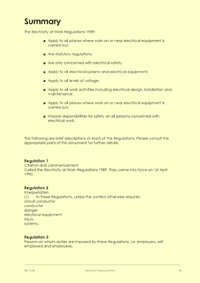 |
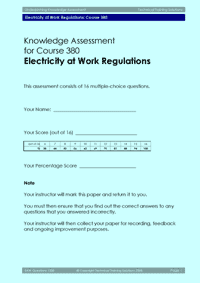 |
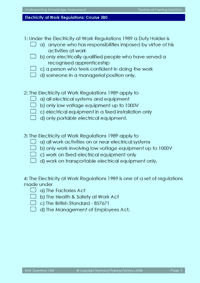 |
Page 43 of the course notes for the Duty Holder (Authorised Person) course, providing a summary of the requirements of each of the EAW Regulations |
Front page of the course assessment of the Duty Holder (Authorised Person) course, explaining the marking system and the instructions to the candidates |
Page 2 of the multiple-choice assessment paper used on the Duty Holder (Authorised Person) course: There are 15 questions in all |
On the second day of the course the candidates are introduced to typical examples of employers' electrical policies and procedures (Company-specific policies for courses that are being run on a customer's premises can be introduced into the course at this stage).
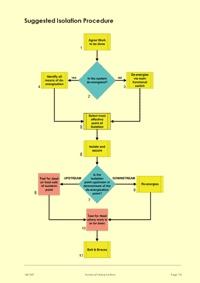 |
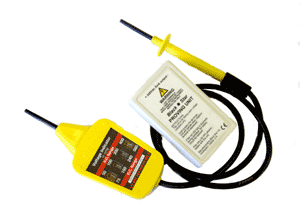 |
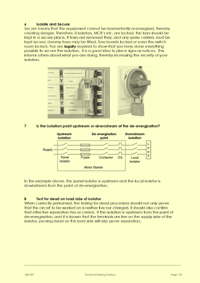 |
Page 13 of the course notes, showing the steps that should be considered within an isolation procedure |
The voltage testers and proving units that we use on the Electrical Isolation and Live Working course |
Page 17 of the course notes, detailing some of our recommended isolation procedures |
The candidates then proceed to apply their knowledge in a demonstrable manner by completing a number of practical equipment isolation exercises. These isolations encompass single phase and three phase isolations on industrial, commercial and domestic systems. The following is one of the units that are used to check that the candidates are able to isolate a single-phase system properly:
This is one of the units that are used to check that the candidates are able to isolate a single-phase system on the electrical isolation part of the course. |
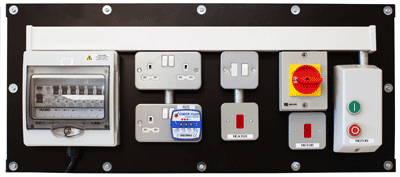 |
The following are two of the panels that are used to check that the candidates are able to isolate three-phase systems properly:
This is one of the panels that are used to check that the candidates are able to isolate three-phase systems on the electrical isolation part of the course. |
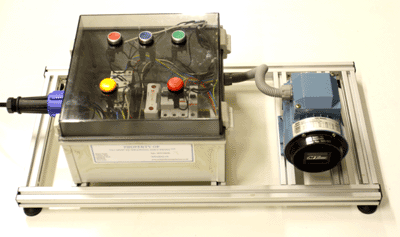 |
This is one of the panels that are used to check that the candidates are able to isolate three-phase systems on the electrical isolation part of the course. |
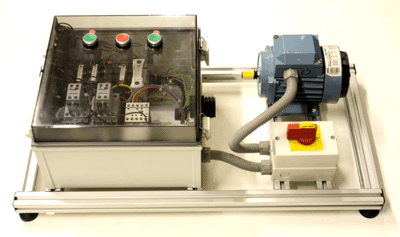 |
The rigs used are slightly different, requiring the candidates to think carefully about the advantages and disadvantages of panel isolations, local or remote isolation versus removal of fuses or locking off circuit breakers inside the panel. They can also explore the merits (or otherwise) of control circuit isolation rather than isolation of the load circuit and how this might be dangerous.
During the Electrical Isolation part of the course the candidates also have to show that they can create a sensitively thought-out isolation procedure for scenarios where production downtime versus the dangers of moving machinery have to be carefully balanced.
The act of testing for dead is explored, and the various ways in which this could be done is explained. We advocate using properly approved voltage testers and proving units. To ensure that the candidates understand this we use a rig that simulates three three-phase motor terminal boxes wired through three isolators. The candidates have to test for dead at each set of motor terminals and some will test out OK whereas others won't and the candidates have to explain what the reasons for this are.
The rig used to practice voltage testing, where candidates use the voltage testers to test for dead on three sets of motor terminals: Some test out OK but some don't and the candidates need to be able to explain why this is. |
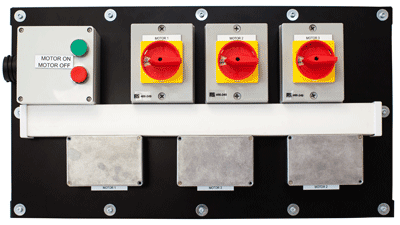 |
We then look at live working. Many of the candidates will presume that they are never going to work live, but on exploration of the legal definition they invariably find that they already are - until equipment is proved dead or during live functional testing, for instance, they are technically working live. A short lecture/discussion around these issues follows, and we discuss the merits of live working risk assessments, the way in which hazardous voltage thresholds can be defined and how the environment can be categorised as kind or unkind. We explore examples of electrical accidents and get the candidates to think about the causes and how the accidents could have been avoided by not working live, using PPE, applying supervision, shrouding terminals etc.
Next we apply the aforementioned knowledge to a series of practical exercises, where the candidates practice making voltage, current and frequency measurements on live equipment. This is often characterised as 'live functional testing' in employers' policies.
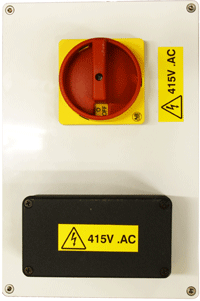 |
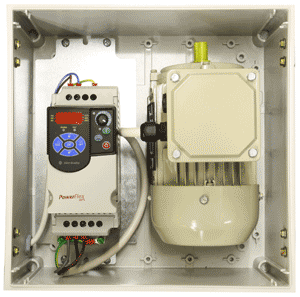 |
 |
The exercise that involves measuring three-phase voltages on the live working part of the course |
The exercise that involves measuring frequency on the live working part of the course |
The exercise that involves measuring three-phase currents on the live working part of the course |
The final exercise on the course requires the candidates to attach a cable to a potentially live set of busbars. This is obviously something that would be extremely difficult to justify and the reasoning behind this needs to be explored so that the candidates can make a meaningful distinction between what is justifiable and what isn't; so that they can clearly see how live functional testing might be allowable whereas the manipulation of live conductors might not be. This also provides the opportunity to explore what their own company policies have to say about these activities. By presenting the candidates with this equipment they are forced to think these issues through, and this is the value of actually doing the exercise - enabling them to think, understand and remember the attendant issues and how they relate to their activities at work. |
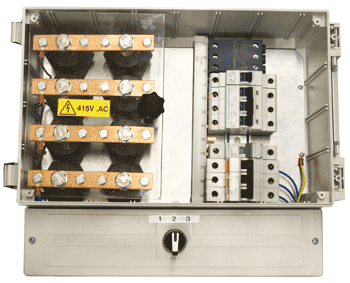 |
 |
Note that even though we've put "Warning 415V" stickers on everything that we do in fact power all of the equipment that has exposed live parts from a three-phase 40V supply, so that the candidates are not in any danger. We don't necessarily tell the candidates about this though! |
If you would like to learn more about the Duty Holder (Authorised Person) course then please call us.


